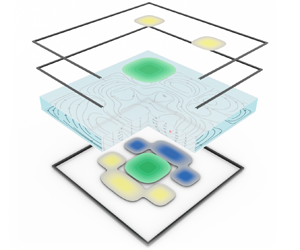Published online by Cambridge University Press: 23 August 2021

Single-phase flow inside a Hele-Shaw cell can exhibit inhomogeneous flow fields, for example when actuated by electroosmosis with varying wall mobilities, leading to internal pressure gradients. We derive a two-dimensional dispersion model for a dissolved species in such a non-uniform flow field, utilizing a multiple-scale perturbation approach. The resulting two-dimensional transport equation is an advection–diffusion equation containing an effective dispersion tensor field and additional advection-correction terms. It can be viewed as a generalization of the well-known Taylor–Aris dispersion model. The dispersion model allows for flow fields with both stationary and oscillatory components. For the special case of non-uniform flow induced by both pressure gradients and electroosmosis, we derive expressions for the flow field in the long-wavelength limit. These include arbitrary, time-dependent functions for both the driving field as well as the wall mobilities. We discuss the general characteristics of the model using a sinusoidally varying wall mobility, and derive analytical expressions for the dispersion tensor. Then, in order to validate the model, we compare three-dimensional Lagrangian particle tracing simulations with the dispersion model for several test cases, including stationary and oscillatory shear flow as well as a recirculating flow field. For each test case, a good agreement between the full three-dimensional simulations and the results of the two-dimensional dispersion model is obtained. The presented model has the potential to significantly simplify computations of mass transport in Hele-Shaw flows.